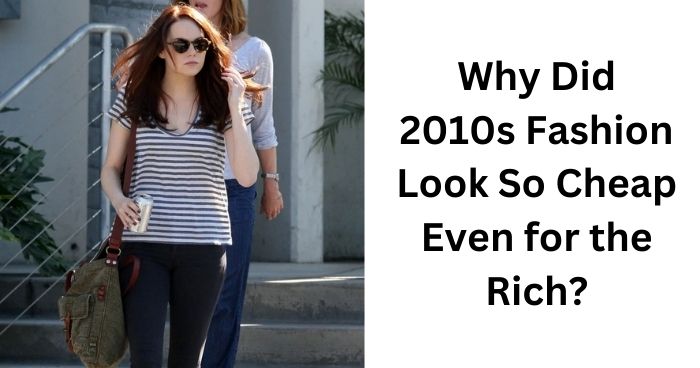Why Did 2010s Fashion Look So Cheap Even for the Rich?
Why did 2010s fashion look so cheap? when looking back at 2010s fashion, one thing stands out: even celebrities and wealthy individuals often appeared to be wearing inexpensive, mass-produced clothing. Why did high-profile figures look like they had just walked out of a Forever 21 store? Was it the norm for even the rich to wear fast fashion, or did expensive clothes simply look cheaper?
Let’s break down why the 2010s had such a distinct “cheap” aesthetic and how it compared to other decades.

1. The Rise of Fast Fashion
One of the biggest reasons 2010s fashion looked cheap was the overwhelming influence of fast fashion brands. H&M, Zara, Forever 21, and Fashion Nova exploded in popularity, making trendy, disposable clothing accessible to the masses. Even celebrities embraced this shift, often sporting these brands instead of luxury, tailor-made outfits.
What Changed?
- In previous decades, high fashion and everyday wear were more distinct. Wealthy individuals opted for custom or designer pieces.
- By the 2010s, brands like H&M and Zara were producing trendy looks at lightning speed, making expensive brands follow their lead rather than setting their own trends.
- Social media and influencer culture promoted constant wardrobe changes, increasing demand for cheap, trendy items.
Even high-end brands started cutting costs, using lower-quality materials and mass production techniques to stay competitive.
2. The “Casualization” of Style
Another major factor was the shift toward everyday, relaxed fashion. In the 2010s, looking “effortlessly casual” became the goal, even among celebrities.
Examples of Popular 2010s Fashion Trends:
- North Face jackets and Ugg boots became staples, prioritizing comfort over refinement.
- Athleisure, with brands like Lululemon and Nike, became mainstream, making leggings and hoodies acceptable daily wear.
- Minimalist “normcore” fashion made plain T-shirts, jeans, and sneakers the go-to uniform.
Rather than showcasing wealth through fine tailoring, people began using logos as status symbols (think Supreme, Gucci logo tees, and Off-White designs). While these items were expensive, their materials and designs often appeared mass-produced.
3. Economic Influence: “Recession-Core”
The 2008 financial crisis left a lasting impact on fashion. Even as economies recovered, frugality became a cultural norm. Many people, including celebrities, opted for simple, practical clothing rather than extravagant styles.
Recession-Core in Action:
- Designer brands started producing simpler, more affordable collections.
- People embraced budget-friendly brands, making them appear just as fashionable as luxury labels.
- Social media made mixing high and low fashion more acceptable, allowing a $10 shirt to be paired with a designer bag.
4. 2010s vs. Other Decades: Why the Difference?
Many people compare 2010s fashion to past decades and notice a stark contrast in quality. Even when trends from the 80s, 90s, or 2000s become outdated, their clothing still appears well-made in photographs. So why does the 2010s stand out?
Possible Reasons:
- Earlier decades had fewer fast fashion options, meaning people invested in better-made clothing.
- The digital age prioritized rapid trends over longevity, leading to a disposable fashion mindset.
- Fashion cycles have always been viewed differently in hindsight—what seems “cheap” today may be nostalgic in another decade.
5. The Shift After 2015: Logo Mania & Diversity in Fashion
By 2016-2019, fashion saw a shift toward luxury streetwear and logo-heavy designs. Brands like Supreme, Off-White, and Gucci dominated, emphasizing branding over craftsmanship.
Additionally, style became more diverse:
- Goth fashion, streetwear, and alternative styles became more visible.
- Luxury brands leaned into high-end streetwear, making sneakers and oversized hoodies part of the high-fashion scene.
- Sustainability movements gained traction, pushing for better-quality clothing.
Final Thoughts: The Legacy of 2010s Fashion
2010s fashion was shaped by a mix of economic shifts, social media influence, and the rise of fast fashion. While it may seem “cheap” in hindsight, its impact on modern fashion is undeniable. Whether it was recession-core minimalism, casual athleisure, or the explosion of logo mania, the decade reflected its time in a way that future generations will continue to analyze.
What do you think? Was 2010s fashion truly “cheap,” or was it just a product of its era?
Source: Reddit
Explore more fashion posts here



